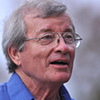Who is this weeping man?
During my first visit to New Camaldoli Hermitage in Big Sur, Calif., I pondered this question as I wept freely amid the rugged hills overlooking the Pacific Ocean.
What was going on with me? I remembered Bill Coffin, then chaplain at Yale, saying he went on a sabbatical “to pay a visit on myself, to see who’s at home.”
So I wondered: Who is this weeping man?
Was I weeping from stored-up grief? Was I weeping at the raw beauty of the breathtaking coastline? The tears dripped as if they had been stored up, waiting for this time of release. I learned to call it the gift of tears.
The doing of ministry can be harmful to your health. I learned the hard way. After two hospitalizations -- bleeding ulcer and, a few years later, heart arrhythmia -- I knew I had to get serious about moderating my hurry-up-and-rush method of ministry. I had to learn to take care of my health, or I’d soon be no good to the 500 members of my congregation. Physical health and spiritual health are connected, and I needed to attend to both.
I was in midcareer, then in my seventh year as pastor of my third church. I decided to take advantage of our sabbatical leave policy. I wanted three months to think, write, meditate and reorient my life and ministry. Since I’d spent snippets of time at monasteries, I decided that my first step was to spend a longer time in a monastic setting.
A wise friend recommended the Hermitage. He told me, “Go. Trust me. Prayer there is palpable.” With this prompting, and my own inner urging, I departed from wife and children and headed like a bird, migrating from North Carolina, to a far-off feeding ground on the West Coast.
I discovered there a monastic community located two miles up a winding road, a place of spectacular beauty, 900 acres of pristine redwoods and bay laurel. It was a long journey from North Carolina, but my dear congregation gave this journey to me as a gift.
I had entreated the monks to let me live “inside the wall,” in a cell, so I could experience the life they live. The cell had a single bed, a bathroom, a chair and a desk, where I wrote in my journal and kept a candle lit whenever I was there. It was a place of solitude and light.
Rising at 5 a.m., I walked in semidarkness down the path to the chapel. The quiet was so delicate that the crunch of my footsteps was loud. In the small chapel the 16 monks, age 25 to 85, entered with the swish of their white robes, bowing first toward the altar and then taking seats in two rows facing each other.
Sitting directly behind the monks, I relished chanting psalms with them, adding my tenor to their resonant a cappella voices. We sang psalms at every service -- 5 a.m. for Vigils, then 7 a.m. for Lauds, 11:30 a.m. Eucharist, 5:30 p.m. Vespers. This was followed by 30 minutes of velvet silence as we sat around the wall of the small rotunda chapel.
Yes, occasionally I felt wet eyes during the silence, too.
During the day, I spoke with the monks to learn why they had come to live in this remote community. Father Raniero stated what the other monks implied: “I’m here to deepen my communion with God.”
Reflecting now on this first of 18 consecutive annual visits to the Hermitage, I’ve come to the conclusion that my weeping has come from feeling at home in this space where communion with the Holy One is the raison d’être, the reason for being.
Being is the right word. After the rampant busyness of my life as a 24/7 on-duty pastor, at the Hermitage I found a major missing component of my health -- a focus on being, not doing. Uncluttered by rush and noise, I discovered a deeper part of my self -- my being-self, where love flows. That’s worth some tears!
The result is that I became an oblate, an associate member of New Camaldoli Hermitage. Yes, I’m still married and still Baptist, but I am now part of a wider community devoted to contemplative life.
These monastic journeys have prompted reflection on Evelyn Underhill’s haunting statement in “The Spiritual Life”:
“We mostly spend [our] lives conjugating three verbs: to Want, to Have, and to Do. … [But] the fundamental verb [is] to Be. … Being, not wanting, having and doing, is the essence of a spiritual life.”
As a long-standing member of the tribe of clergy, I dare say that we clergy (and our lay leaders) spend most of our time wanting, having and doing. But we typically do a mediocre job of attending to our being.
I recently retired after more than 40 years in pastoral ministry. I’ve loved being a pastor. I’m well-acquainted with the delights and blessings of ministry. We ministers are privileged to be in relationship at the crucial times of people’s lives -- from birth to student years, family life, work transitions, health issues and the death of loved ones. While surely blessed by these relationships, ministers are also too familiar with the pressures, fatigue and frustrations that come with the role of pastor.
Ministers seek to be available to parishioners, especially at the decisive, crisis moments. In addition to the many relationships, there are also the tasks of preaching, leading worship, directing staff, teaching, guiding mission efforts in the community and overseeing the work of various committees. It’s a daunting assignment, at times overwhelming.
Underhill’s challenge screams like a rebuke: We spend our lives wanting, having and doing. But what about the essential verb: to be? Because of duties and distractions, I find that most ministers make a puny investment in being. We’ve sidestepped Shakespeare’s classic words from “Hamlet”: “To be or not to be: that is the question.”
Following my first visit to the Hermitage, I finally made a confession to my church officials. With Underhill’s words pressing down on me, I got up my Type A courage and said in my annual review with the personnel committee, “My No. 1 goal is to take care of my spiritual and physical health.” Gasp!
Why did it take me so long? I grew up with drilled-in instruction that other people come first, then the dog and the cat, and yourself last. Idealism run amok! Even the flight attendants tell us, “Put the oxygen mask on yourself first, then turn to help others.” Some of us are slow learners.
During the lovely service of Eucharist at the Hermitage, I was watching intently as the presiding priest, concluding the liturgy, reached to take the bread and cup, partaking first, before inviting the people to come forward. That was a revelation!
At communion in my tradition, the minister is served last, after everyone else is served. The symbolism was striking. How can the minister give what he or she has not received? Or, as one of my members said, “You can’t pour from the pitcher what’s not in it.”
To do ministry (yes, it’s “doing”) for the long haul, one must find practices to sustain health and well-being. Flying off to a California monastery may seem exotic, even unreachable.
But there is a “monastery” within a day’s journey for most of us. One needs to find the sacred place, the sacred center that invites a deeper communion with the Holy One, who is the Ground of Being.
But first we must get quiet, stop doing and start receiving the gifts of being. Even if one of them is the gift of tears.








